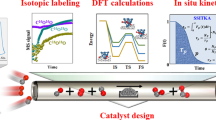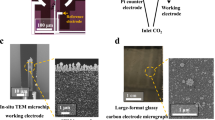Abstract
Due to a general feedstock shift, the chemical industry is charged with the task of finding ways to transform renewable ketones into value-added products. A viable route to do so is the electrochemical hydrogenation of the carbonyl functional group. Here we report a study on acetone reduction at platinum single-crystal electrodes using online electrochemical mass spectroscopy, in situ Fourier transform infrared spectroscopy and density functional theory calculations. Acetone reduction at platinum displays a remarkable structural sensitivity: not only the activity, but also the product distribution depends on the surface crystallographic orientation. At Pt(111) neither adsorption nor hydrogenation occur. A decomposition reaction that deactivates the electrode happens at Pt(100). Acetone reduction proceeds at the (110) steps: Pt[(n – 1)(111) × (110)] electrodes produce 2-propanol and Pt[(n + 1)(100) × (110)] electrodes produce propane. Using density functional theory calculations, we built a selectivity map to explain the intricacies of the acetone reduction on platinum. Finally, we extend our conclusions to the reduction of higher aliphatic ketones.
This is a preview of subscription content, access via your institution
Access options
Access Nature and 54 other Nature Portfolio journals
Get Nature+, our best-value online-access subscription
$29.99 / 30 days
cancel any time
Subscribe to this journal
Receive 12 digital issues and online access to articles
$119.00 per year
only $9.92 per issue
Buy this article
- Purchase on Springer Link
- Instant access to full article PDF
Prices may be subject to local taxes which are calculated during checkout







Similar content being viewed by others

Data availability
All the data are available from the authors upon reasonable request.
References
Brown, T. R. & Brown, R. C. What role for the bioeconomy in an electrified transportation sector? Biofuels, Bioprod. Bior. 11, 363–372 (2017).
Imam, T. & Capareda, S. Characterization of bio-oil, syn-gas and bio-char from switchgrass pyrolysis at various temperatures. J. Anal. Appl. Pyrol. 93, 170–177 (2012).
Oasmaa, A., Elliott, D. C. & Korhonen, J. Acidity of biomass fast pyrolysis bio-oils. Energy Fuels 24, 6548–6554 (2010).
Abu Bakar, M. S. & Titiloye, J. O. Catalytic pyrolysis of rice husk for bio-oil production. J. Anal. Appl. Pyrol. 103, 362–368 (2013).
Villalba, M., del Pozo, M. & Calvo, E. J. Electrocatalytic hydrogenation of acetophenone and benzophenone using palladium electrodes. Electrochim. Acta 164, 125–131 (2015).
Cantu, D. C. et al. A combined experimental and theoretical study on the activity and selectivity of the electrocatalytic hydrogenation of aldehydes. ACS Catal. 8, 7645–7658 (2018).
Song, Y. et al. Hydrogenation of benzaldehyde via electrocatalysis and thermal catalysis on carbon-supported metals. J. Catal. 359, 68–75 (2018).
Kwon, Y., de Jong, E., Raoufmoghaddam, S. & Koper, M. T. M. Electrocatalytic hydrogenation of 5-hydroxymethylfurfural in the absence and presence of glucose. ChemSusChem 6, 1659–1667 (2013).
Kwon, Y., Birdja, Y. Y., Raoufmoghaddam, S. & Koper, M. T. M. Electrocatalytic hydrogenation of 5-hydroxymethylfurfural in acidic solution. ChemSusChem 8, 1745–1751 (2015).
Chadderdon, X. H. et al. Mechanisms of furfural reduction on metal electrodes: distinguishing pathways for selective hydrogenation of bioderived oxygenates. J. Am. Chem. Soc. 139, 14120–14128 (2017).
Hazzazi, O. A. et al. Electrochemical studies of irreversibly adsorbed ethyl pyruvate on Pt{hkl} and epitaxial Pd/Pt{hkl} adlayers. J. Electroanal. Chem. 640, 8–16 (2010).
Rees, N. V. et al. In situ surface-enhanced Raman spectroscopic studies and electrochemical reduction of α-ketoesters and self condensation products at platinum surfaces. J. Phys. Chem. C 115, 1163–1170 (2011).
Orito, Y., Imai, S. & Niwa, S. Asymmetric hydrogenation of methyl pyruvate using Pt–C catalyst modified with cinchonidine. Nippon Kagaku Kaishi 1979, 1118–1120 (1979).
Baltruschat, H. & Ernst, S. Molecular adsorbates at single-crystal platinum-group metals and bimetallic surfaces. ChemPhysChem 12, 56–69 (2011).
Kita, H., Saito, K. & Katayama, A. Electroreduction of acetone on platinum in sulfuric acid solution and catalytic action of platinum and mercury electrodes. J. Res. Inst. Catal. 25, 45–62 (1977).
Bänsch, B., Härtung, T., Baltruschat, H. & Heitbaum, J. Reduction and oxidation of adsorbed acetone at platinum electrodes studied by DEMS. J. Electroanal. Chem. Interfacial Electrochem. 259, 207–215 (1989).
de Hemptinne, X. & Schunck, K. Electrochemical reduction of acetone. Electrocatalytic activity of platinized platinum. Trans. Faraday Soc. 65, 591–597 (1969).
Horányi, G. On the adsorption of organic compounds on platinized platinum electrodes. J. Electroanal. Chem. Interfacial Electrochem. 51, 163–178 (1974).
Horányi, G. Electrocatalytic reductive splitting of C–O and C–OH bonds at platinum electrodes. Electrochim. Acta 31, 1095–1103 (1986).
Calle-Vallejo, F. & Bandarenka, A. S. Enabling generalized coordination numbers to describe strain effects. ChemSusChem 11, 1824–1828 (2018).
Löffler, T., Bussar, R., Xiao, X., Ernst, S. & Baltruschat, H. The adsorption of ethene on vicinally stepped electrode surfaces and the effect of temperature. J. Electroanal. Chem. 629, 1–14 (2009).
Calle-Vallejo, F. et al. Why conclusions from platinum model surfaces do not necessarily lead to enhanced nanoparticle catalysts for the oxygen reduction reaction. Chem. Sci. 8, 2283–2289 (2017).
Iwasita, T. & Pastor, E. A DEMS and FTIR spectroscopic investigation of adsorbed ethanol on polycrystalline platinum. Electrochim. Acta 39, 531–537 (1994).
Zaki, M. I., Hasan, M. A. & Pasupulety, L. In situ FTIR spectroscopic study of 2-propanol adsorptive and catalytic interactions on metal-modified aluminas. Langmuir 17, 4025–4034 (2001).
McMurry, H. L. & Thornton, V. The infrared spectra of propane and its symmetrical deuterium substituted analogs. J. Chem. Phys. 19, 1014–1018 (1951).
Dellepiane, G. & Overend, J. Vibrational spectra and assignment of acetone, ααα acetone-d 3 and acetone-d 6. Spectrochim. Acta 22, 593–614 (1966).
Avery, N. R. EELS identification of the adsorbed species from acetone adsorption on Pt(111). Surf. Sci. 125, 771–786 (1983).
Koper, M. T. M. Thermodynamic theory of multi-electron transfer reactions: implications for electrocatalysis. J. Electroanal. Chem. 660, 254–260 (2011).
Pohl, M. D., Watzele, S., Calle-Vallejo, F. & Bandarenka, A. S. Nature of highly active electrocatalytic sites for the hydrogen evolution reaction at Pt electrodes in acidic media. ACS Omega 2, 8141–8147 (2017).
Bondue, C. J. & Koper, M. T. M. A mechanistic investigation on the electrocatalytic reduction of aliphatic ketones at platinum. J. Catal. 369, 302–311 (2019).
Nielsen, A. T. & Houlihan, W. J. The Aldol Condendation. Organic Reactions https://onlinelibrary.wiley.com/doi/full/10.1002/0471264180.or016.01 (2004).
Clavilier, J., Armand, D., Sun, S. G. & Petit, M. Electrochemical adsorption behaviour of platinum stepped surfaces in sulphuric acid solutions. J. Electroanal. Chem. Interfacial Electrochem. 205, 267–277 (1986).
Clavilier, J., El Achi, K. & Rodes, A. In situ probing of step and terrace sites on Pt(S)-[n(111) × (111)] electrodes. Chem. Phys. 141, 1–14 (1990).
Michaelis, R. & Kolb, D. M. Stability and electrochemical properties of reconstructed Pt(110). J. Electroanal. Chem. 328, 341–348 (1992).
Wonders, A. H., Housmans, T. H. M., Rosca, V. & Koper, M. T. M. On-line mass spectrometry system for measurements at single-crystal electrodes in hanging meniscus configuration. J. Appl. Electrochem. 36, 1215–1221 (2006).
Grimaud, A. et al. Activating lattice oxygen redox reactions in metal oxides to catalyse oxygen evolution. Nat. Chem. 9, 457 (2017).
Iwasita, T., Nart, F. C. & Vielstich, W. An FTIR study of the catalytic activity of a 85:15 Pt:Ru alloy for methanol oxidation. Ber. Bunsenges. Phys. Chem. 94, 1030–1034 (1990).
Kresse, G. & Furthmüller, J. Efficient iterative schemes for ab initio total-energy calculations using a plane-wave basis set. Phys. Rev. B 54, 11169–11186 (1996).
Perdew, J. P., Burke, K. & Ernzerhof, M. Generalized gradient approximation made simple. Phys. Rev. Lett. 77, 3865–3868 (1996).
Kresse, G. & Joubert, D. From ultrasoft pseudopotentials to the projector augmented-wave method. Phys. Rev. B 59, 1758–1775 (1999).
Monkhorst, H. J. & Pack, J. D. Special points for Brillouin-zone integrations. Phys. Rev. B 13, 5188–5192 (1976).
Nørskov, J. K. et al. Origin of the overpotential for oxygen reduction at a fuel-cell cathode. J. Phys. Chem. B 108, 17886–17892 (2004).
Calle-Vallejo, F. & Koper, M. T. M. Theoretical considerations on the electroreduction of CO to C2 species on Cu(100) electrodes. Angew. Chem. Int. Ed. 52, 7282–7285 (2013).
He, Z.-D., Hanselman, S., Chen, Y.-X., Koper, M. T. M. & Calle-Vallejo, F. Importance of solvation for the accurate prediction of oxygen reduction activities of Pt-based electrocatalysts. J. Phys. Chem. Lett. 8, 2243–2246 (2017).
Calle-Vallejo, F., Martínez, J. I., García-Lastra, J. M., Sautet, P. & Loffreda, D. Fast prediction of adsorption properties for platinum nanocatalysts with generalized coordination numbers. Angew. Chem. Int. Ed. 53, 8316–8319 (2014).
Calle-Vallejo, F., Sautet, P. & Loffreda, D. Understanding adsorption-induced effects on platinum nanoparticles: an energy-decomposition analysis. J. Phys. Chem. Lett. 5, 3120–3124 (2014).
Calle-Vallejo, F. et al. Finding optimal surface sites on heterogeneous catalysts by counting nearest neighbors. Science 350, 185–189 (2015).
Calle-Vallejo, F., Pohl, M. D. & Bandarenka, A. S. Quantitative coordination–activity relations for the design of enhanced Pt catalysts for CO electro-oxidation. ACS Catal. 7, 4355–4359 (2017).
Acknowledgements
This research received funding from the Netherlands Organization for Scientific Research (NWO) in the framework of the fund New Chemical Innovations (project 731.015.204 ELECTROGAS) with financial support from Akzo Nobel Chemicals, Shell Global Solutions, Magneto Special Anodes (Evoqua Water Technologies) and Elson Technologies. F.C.-V. thanks the Spanish MEC for a Ramón y Cajal research contract (RYC-2015-18996) and acknowledges financial support from the Units of Excellence María de Maeztu programme through grant MDM-2017–0767. The use of supercomputing facilities at SURFsara was sponsored by NWO Physical Sciences, with financial support by NWO.
Author information
Authors and Affiliations
Contributions
C.J.B. co-conducted the FTIR experiments and conducted the remaining experimental work (that is, CV, OLEMS and surface enhanced Raman spectroscopy studies), co-conceived the concept of the presented work and co-wrote the manuscript. F.C.V. conducted the theoretical modelling, co-conceived the concept of the presented work and co-wrote the manuscript. M.C.F. co-conducted the FTIR experiments. M.T.M.K. co-conceived the concept of the presented work and co-wrote the manuscript.
Corresponding author
Ethics declarations
Competing interests
The authors declare no competing interests.
Additional information
Publisher’s note: Springer Nature remains neutral with regard to jurisdictional claims in published maps and institutional affiliations.
Supplementary information
Supporting Information
Supplementary Notes 1–11; Supplementary Figures 1–31; Supplementary Tables 1–3; Supplementary References
Rights and permissions
About this article
Cite this article
Bondue, C.J., Calle-Vallejo, F., Figueiredo, M.C. et al. Structural principles to steer the selectivity of the electrocatalytic reduction of aliphatic ketones on platinum. Nat Catal 2, 243–250 (2019). https://doi.org/10.1038/s41929-019-0229-3
Received:
Accepted:
Published:
Issue Date:
DOI: https://doi.org/10.1038/s41929-019-0229-3
This article is cited by
-
Preparation of Sub-5 nm Pt Nanotetrahedra Without Surfactant and Their Electrocatalytic Properties
Catalysis Letters (2024)
-
Nano-encapsulation: overcoming conductivity limitations by growing MOF nanoparticles in meso-porous carbon enables high electrocatalytic performance
NPG Asia Materials (2023)
-
Electrochemical carbonyl reduction on single-site M–N–C catalysts
Communications Chemistry (2023)
-
Electrocatalytic dual hydrogenation of organic substrates with a Faradaic efficiency approaching 200%
Nature Catalysis (2023)
-
Unraveling the electrocatalytic reduction mechanism of enols on copper in aqueous media
Nature Communications (2022)


